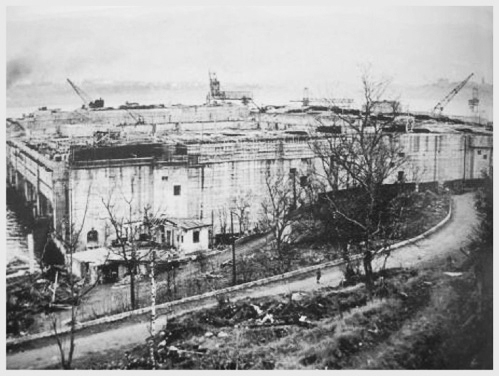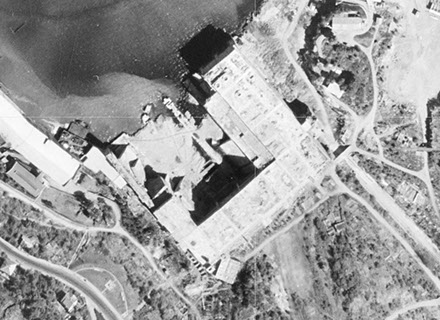Base de sous-marins Bruno à Bergen
La conquête de la Norvège en 1940 donna aux allemands une opportunité unique de rapprocher leurs U-boats du front. La construction d’un bunker pour sous-marins à Bergen débuta en 1941. Le bunker comporte 7 alvéoles; 3 sont des bassins de radoub, 3 autres des bassins à flot et une dernière sert au mouillage. C’est la 11eme Flotille d’U-boats de la Kriegsmarine, transférée d’Allemagne qui installa son quartier général à Bergen.
Suite au débarquement allié en France en Juin 1944 il y eut un afflux de sous- marins qui provoqua un raid massif de la RAF en Octobre 1944 avec plus de 150 appareils. L’attaque vira au désastre quand 193 civils norvégiens dont 61 enfants d’une école avoisinante, furent tués. Bien que touché à plusieurs reprises, le bunker demeura intact, 2 U-boats seulement étant endommagés. Une nouvelle attaque au cours du mois d’Octobre échoua quand les 244 appareils ne purent trouver la cible en raison d’une épaisse couche nuageuse. Quelques appareils larguèrent leurs bombes, mais sans toucher le bunker.
La 3eme et dernière attaque aérienne se déroula en Janvier 1945, quand 33 bombardiers embarquant chacun une bombe "Tallboy" de 6 tonnes attaquèrent la base. Le bunker fut directement touché à trois reprises. 20 allemands furent tués et 2 U-boats endommagés quand l’une des bombes traversa la toiture.
Comme toutes les bases navales allemandes, la base de Bergen était nommée d’après l’alphabet phonétique allemand. Etant située à Bergen, et «Bruno» étant l’indicatif phonétique du «B», elle devint la base Bruno. Le bunker est à présent utilisé par la marine norvégienne pour l’entretien et le dépôt de ses sous-marins.
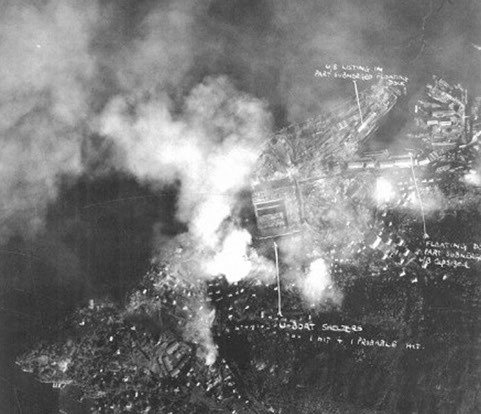
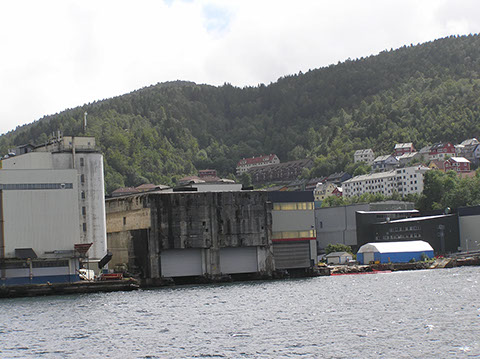
© Photo prise par Willem Nabuurs
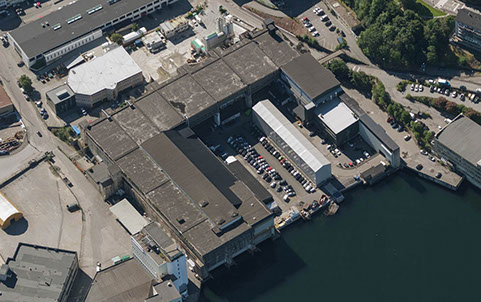
“ I have recently come into possession of my father's WW2 Pilots Log Book and noticed that he flew on a mission on January 12th 1945 to attack the U-boat pens at Bergen with a "Tallboy" bomb.
Having struck the target and headed back to England he noticed 4 Mustangs approaching but they turned out to be 4 109's which shot his Lancaster to pieces as he took avasive action.
The 109's ran out of ammunition as did the Lancaster with damaged hydrologic lines but managed to limp back to England with only one injured crew member, rear gunner - who did recover.
The aircraft had 1100 holes in the fuselage when it was inspected on the ground, the crew were flown back to their Bardney, Lincolnshire base the following day. ”
John Harris
“ RAF Campaign Diary 12/1-1945:
32 Lancasters and 1 Mosquito of Nos 9 and 617 Squadrons attacked U-boat pens and shipping in Bergen harbor. 3 Lancasters of No 617 Squadron and 1 from No 9 Squadron were lost; the Germans told the local people that 11 bombers had been shot down. A local report says that 3 Tallboys penetrated the 3½-metre-thick roof of the pens and caused severe damage to workshops, offices and stores inside. ”
Chris Kirkegaard
“ This raid damaged the U864, delaying her departure. She was later sunk by HMS Venturer as she sailed from Bergen to Japan. The British put a lot of effort into sinking that boat and there is a theory that the raid was less about the bunker, and more about U864. ”
Mike
“ The U864 is still at the bottom of the sea west of the Norwegian island Fedje. It is loaded with mercury, and there is discussions in Norway how to best deal with the pollution. The options are to raise the U-boat or to cover it where it is.”
Per Daniel
